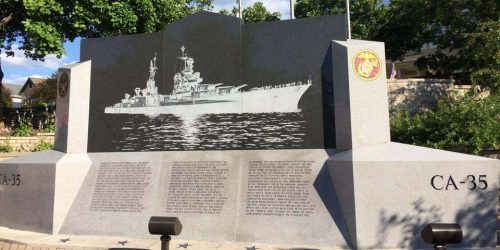Indiana at 200: The USS Indianapolis

The memorial to the USS Indianapolis tells the history of the cruiser on one side and lists the names of crew members on the other. Photo by Brent Watts.
by Andrea Neal
The city of Indianapolis will be forever linked to one of the worst naval disasters in history: the sinking of the USS Indianapolis in World War II.
This was the 10,000-ton cruiser that delivered secret components for the atomic bomb to be used against Japan, only to be sunk by Japanese torpedoes on the return trip. More than 870 men died in shark-filled waters, and the ship’s captain, Charles McVay, was unjustly court martialed, his name cleared long after he took his own life.
It’s a story that deserved a better ending. The Indianapolis was the pride of the U.S. Navy, equipped with the latest technology and capable of traveling at 32 knots, over 36 miles per hour. “Her speed and massive firepower truly captured the spirit of America,” said Edgar Harrell, a survivor from Clarksville, Tenn.
When the boat launched in 1931, its connection to Indianapolis was in name only. The U.S. Navy traditionally names cruisers after cities. In the years since, both Indianapolis and the survivors forged a meaningful relationship aimed at preserving its story.
On the eve of war, the ship’s homeport was Pearl Harbor; luckily, on Dec. 7, 1941, she was performing exercises at Johnston Island 500 miles west of Hawaii. After the bombing of Pearl Harbor, she immediately joined the search for the attacking Japanese carriers and remained in operation against the enemy until her sinking.
Because of her reputation, the Indianapolis was selected in July 1945 to transport components for one of the atomic bombs that would be used to destroy Hiroshima and Nagasaki. She did so with amazing speed, covering 5,000 miles from San Francisco to Tinian Island – in the Pacific Ocean south of Japan – in only 10 days.
After the successful mission, the Indianapolis headed back to Leyte in the Philippines for training exercises in advance of an expected U.S. invasion of Japan.
She was halfway between the Philippines and Guam when a Japanese submarine I-58, commanded by Mochitsura Hashimoto, spotted her. At 12:15 a.m. on July 30, two torpedoes struck the Indianapolis on her bow and starboard side.
Of 1,196 men on board, some 300 went down with the boat. The rest jumped into pitch-dark water, infested with sharks, with only a few life rafts and almost no food or water. For reasons never made clear by the Navy, the ship was not missed, and by the time the survivors were noticed by a pilot in the area four days later only 316 men were alive.
The Navy did not release the news to the press until August 15, the day Japan surrendered, no doubt to ensure the disaster would be overshadowed by joyous news.
McVay survived, was court-martialed and convicted of “hazarding his ship by failing to zigzag,” a movement that could have evaded a torpedo strike. Evidence was overwhelming that the Navy itself had placed the ship in harm’s way, and that McVay was under no requirement to zigzag. Materials later declassified suggest the Navy was trying to cover up its own culpability.
Thanks to relentless efforts of survivors and a 1996 National History Day project by Florida sixth grader Hunter Scott, both Congress and the Navy cleared McVay of wrongdoing in 2000 and 2001 respectively. Vindication came too late for McVay who killed himself in 1968 using his Navy-issued pistol.
Since 1960, survivors have routinely held reunions in Indianapolis to commemorate the bravery of the crew. In 1995, the USS Indianapolis National Memorial was dedicated along the city’s Downtown canal. In 2007, the USS Indianapolis Museum opened as a gallery within the Indiana War Memorial.
